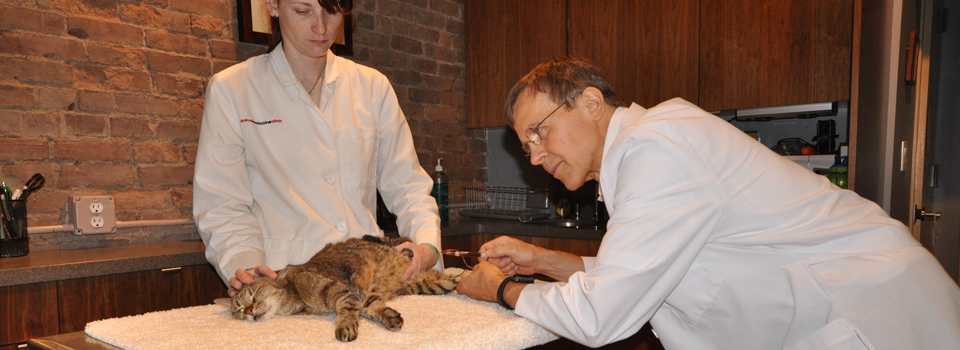The endocrine system is the system of glands, each of which secretes a type of hormone into the bloodstream to regulate the body. While powerful, the endocrine organs are relatively small.
Hormones are chemical messengers that have many different functions. In the bloodstream, the hormones travel throughout the body. Their effects vary widely, and all are important for life. Some familiar examples of hormones include insulin, thyroid hormone, and cortisol. These hormones are important in the development of diabetes, hypo- and hyperthyroidism, and Cushing’s disease, respectively.
Human endocrine glands are essentially identical to dog and cat endocrine glands, both in structure and function. The endocrine glands include the pituitary gland, thyroid gland, parathyroid glands, pancreas, adrenal glands, ovaries, and testes.

Pituitary Gland
The pituitary gland is located near the center and bottom of the brain. It produces a number of critical hormones that control many parts of the body, including several other endocrine glands. Because of its central role, the pituitary gland is often referred to as the “master gland.”
Clinically, the most important of these hormones include growth hormone (GH), adrenocorticotropin (ACTH), thyroid-stimulating hormone (TSH), and antidiuretic hormone (ADH). Because the pituitary gland produces so many hormones, pituitary disease, most commonly pituitary tumors, may result in a variety of different conditions. The signs and symptoms of the disease depend on which pituitary hormones are affected.
Thyroid Gland
The thyroid gland is a two-lobed gland in the neck, located in front of the breathing airway (trachea) and below the Adam's apple. It produces two iodine-containing hormones, thyroxine (also called T4) and triiodothyronine (T3). In general, the thyroid hormones regulate metabolic rate, or the speed at which body processes “run.”
Thyroid disorders result from too little or too much T3 or T4. Symptoms of hypothyroidism (too little hormone) include decreased energy, lethargy, weight gain, dry skin, and hair loss. In young animals, hypothyroidism most commonly leads to stunted growth and dwarfism. Hyperthyroidism (too much hormone) is common in cats. Common clinical signs include weight loss despite an increased appetite, nervousness, excitability, vomiting after eating, and increased thirst and urination.
Parathyroid Glands
The parathyroid glands are four small glands located adjacent or within the thyroid gland. These glands secrete parathyroid hormone (PTH). PTH helps maintain normal calcium and phosphorous levels in the body and is necessary for proper bone development.
If the parathyroids are removed during a thyroid operation, the blood PTH will fall (hypoparathyroidism). The blood calcium will then become dangerously low (hypocalcemia), causing neuromuscular signs of muscle spasms or twitches, tetany, or seizures.
A tumor of one of the parathyroid glands may cause the secretion or release too much PTH (hyperparathyroidism). The blood calcium will then become too high (hypercalcemia), causing increased thirst and urination, muscle weakness, and fatigue.
Endocrine Pancreas
The pancreas is an oblong, flattened gland located in the abdomen, adjacent to the stomach and small intestine. While it secretes digestive juices to aid in digestion, its endocrine function is to maintain healthy glucose (blood sugar) levels. If blood sugar is too high, such as after a meal, the pancreas secretes insulin. Insulin moves the sugar from the blood into the cells of the body, where it is used for energy. If blood sugar is too low, the pancreas releases glucagon. Glucagon releases sugar, stored in the liver as glycogen, back into the bloodstream.
Diabetes, an imbalance of blood sugar levels, is the major disorder of the pancreas. Diabetes occurs when the pancreas does not produce enough insulin or the body is resistant to the insulin in the blood. Without enough insulin to keep glucose moving through the metabolic process, the blood glucose level rises too high. Most dogs and cats with diabetes require insulin shots to do well, although some can be managed by a combination of diet or oral drugs.
A condition called hyperinsulinism is caused by too much insulin and leads to hypoglycemia (low blood sugar). This is most commonly seen when owners inadvertently overdose their diabetic dogs or cats with insulin. Less commonly, an insulinoma (insulin-secreting pancreatic tumor) will cause hypoglycemia. Symptoms of low blood sugar include anxiety, weakness, and seizures.
Adrenal Glands
The two adrenal glands are located on the top of each kidney. The adrenal glands essentially contain two separate endocrine organs. The outer portion or core of the adrenal gland is called the adrenal cortex. The inner portion of the gland is called the adrenal medulla. The hormones of the adrenal cortex are essential for life and the hormones of the adrenal medulla are not.
The adrenal cortex produces glucocorticoids (e.g., cortisol) that help the body control blood sugar, increase the burning of protein and fat, and respond to stressful stimuli, such as fever, major illness, and injury. The mineralocorticoids (e.g., aldosterone) control blood volume and help to regulate blood pressure by helping the kidneys hold on to sodium and water. Cushing’s syndrome (too much cortisol) and Addison’s disease (too little cortisol) are the two most common adrenal cortex disorders. Symptoms of Cushing’s syndrome generally include an increase in thirst and urination, enlarged abdomen, and hair loss on the trunk. Symptoms of Addison’s disease include poor appetite, weight loss, weakness, and vomiting.
The adrenal medulla produces epinephrine (adrenaline), which increases heart rate, opens airways to improve oxygen intake, and increases blood flow to muscles. The adrenal medulla usually secretes epinephrine when one is scared, excited, or under stress. The adrenal medulla also secretes norepinephrine, but this hormone is more related to maintaining normal activities as opposed to emergency reactions. Tumors of the adrenal medulla (called pheochromocytoma) may produce increased thirst and urination, increased heart rate, and restlessness.
Testes
As in humans, unneutered male dogs and cats have twin reproductive glands, called testes, which produce the hormone testosterone. Testosterone helps the young male develop and then maintain his sexual traits.
Ovaries
The female reproductive glands, the ovaries, produce estrogen and progesterone. These hormones are responsible for developing and maintaining female sexual traits, as well as maintaining a pregnancy. Along with certain pituitary hormones (i.e., luteinizing hormone [LH] and follicle-stimulating hormone [FSH]), they control the estrus cycle (a sort of “menstrual cycle” for animals, although animals do not menstruate).




